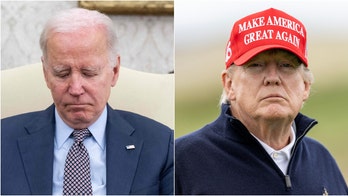
An electrical grid (AP)
The Supreme Court announced Monday it will give further consideration to a closely-watched lawsuit filed by environmentalists, eight states and New York City blaming the problems associated with global warming on the carbon dioxide output of five major power companies.
An ultimate judgment against the energy providers could lead to dramatic changes in the energy marketplace and ripple into other industries. But the high court's decision to give the matter closer attention makes that possibility less likely.
In 2009, the Second Circuit U.S. Court of Appeals ruled that the plaintiffs could move forward with their lawsuit alleging the companies were creating a public nuisance by releasing excessive amounts of carbon dioxide into the air.
That decision "sets a major precedent in that it gives citizens -- in the absence of climate change legislation -- the right to take action against big business pollution," according to a statement released last September by Open Space Institute, one three environmental groups that joined the lawsuit along with New York City and Connecticut, New York, California, Iowa, New Jersey, Rhode Island, Vermont and Wisconsin.
In asking the high court to review the case, lawyers for the power companies said the plaintiffs have no standing to file a lawsuit. Instead, they contend, only the federal government through the Environmental Protection Agency has the ability to hold power companies accountable for contributing to global warming.
In 2007, the Supreme Court issued a controversial 5-4 ruling giving the EPA that authority under the Clear Air Act.
The companies argue that chaos will erupt if judges are effectively given the same authority as environmental regulators. "At stake is the financial health and security of numerous sectors of the economy ... (it) could transform the way the United States produces and obtains energy, limit its supply, dramatically raise its cost and jeopardize reliable service to the public," lawyer Peter Keisler wrote to the court.
The states claim the power companies have caused irreparable environmental harm by allowing its plants to produce excessive levels of carbon dioxide. They claim people have died because of their actions and others have been directly impacted by the resulting smog, decreased fresh water supplies, land erosion and rising sea levels. Their suit was filed before the 2007 decision in Massachusetts v. EPA and the Second Circuit's 2009 ruling came before the EPA had started to regulate carbon emissions.
In a move that environmental groups likely found disappointing, the Obama administration didn't ask the high court to allow the suit to continue. Instead, the government asked the justices to remand the case back to the Second Circuit for further review to see if it was necessary.
In his brief, acting Solicitor General Neal Katyal said recent actions by the EPA show the feds are now regulating carbon emissions. "
It is now clear, in light of intervening developments that any federal common-law cause of action against (the power companies) for their emissions has been displaced," Katyal wrote.
A unique aspect to the case, American Electric Power Company v. Connecticut, is that Justice Sonia Sotomayor was on the Second Circuit panel that originally heard the case. That court's unanimous decision, made by the other two presiding judges, was delayed until after she joined the high court in August 2009.
It's unknown if Sotomayor would have joined her former colleagues, but Monday's announcement from the court also noted that she had not participated in the consideration of this decision.




